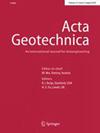A fully resolved SPH-DEM for simulation of debris flows with arbitrary particle shapes impacting flexible barriers
Abstract
This study presents a fully resolved numerical method coupling framework for capturing the interaction between debris flows and flexible barriers. The proposed coupling method combines a simplified flexible wire representation, smoothed particle hydrodynamics (SPH), and discrete element method (DEM). Specifically, the flexible wire representation is used to represent a flexible barrier that intercepts debris flows. The coupled SPH-DEM simulates a two-phase debris flow containing arbitrarily shaped boulders. Additionally, a modified dynamic boundary method (mDBC) is employed to couple SPH with DEM. These three methods are strongly coupled to simulate the behavior of boulders in debris flows and improve the efficiency and accuracy of the interaction between flexible barriers and debris flows. The proposed coupling framework is evaluated through a series of verification instances, which are consistent with experimental observations. Subsequently, the impact dynamics of the two-phase debris flow on the flexible barrier is modeled and analyzed. Overall, the framework holds great potential for the design and optimization of flexible barriers for debris flow mitigation in engineering practice.

 求助内容:
求助内容: 应助结果提醒方式:
应助结果提醒方式:


